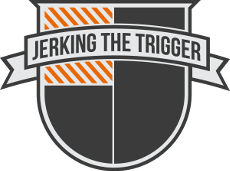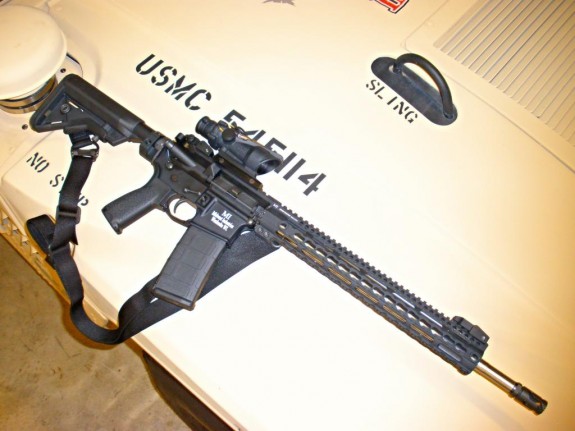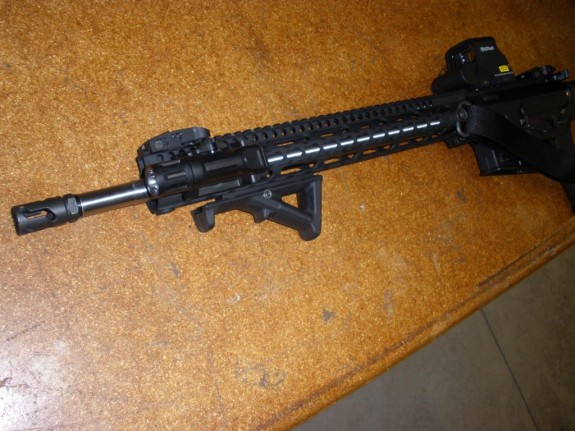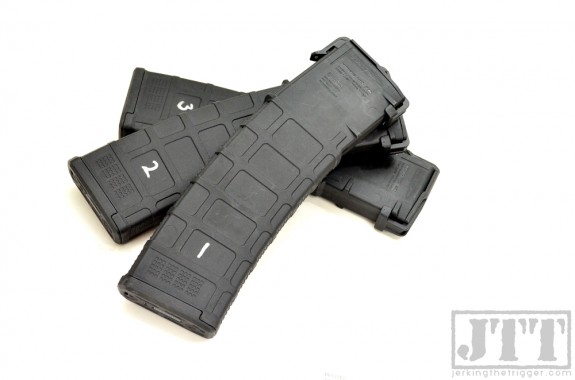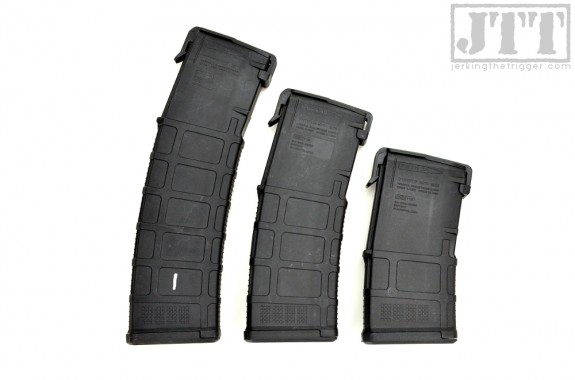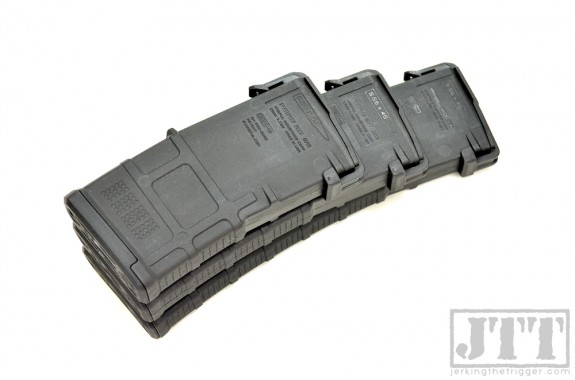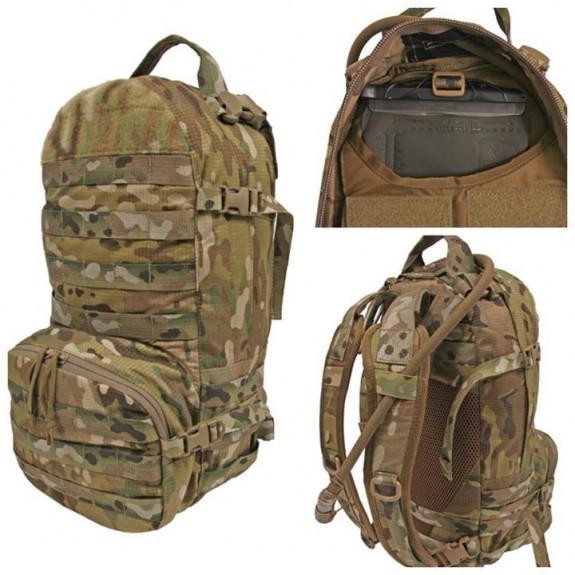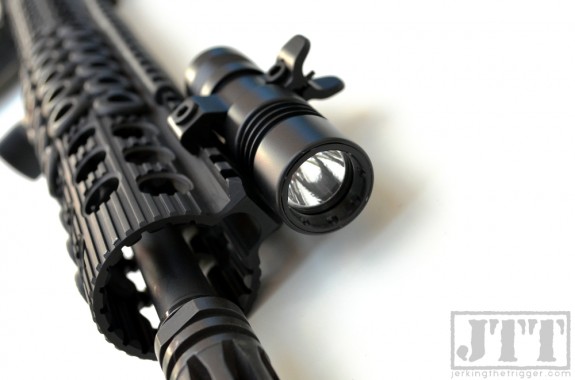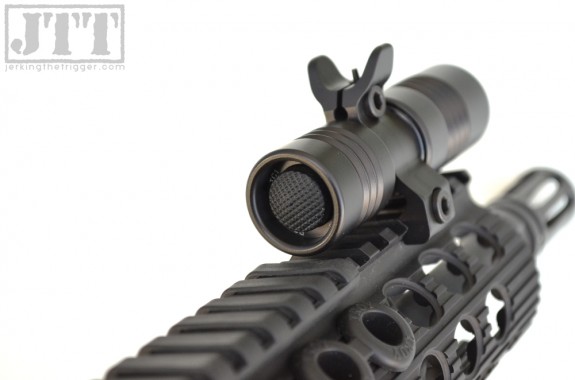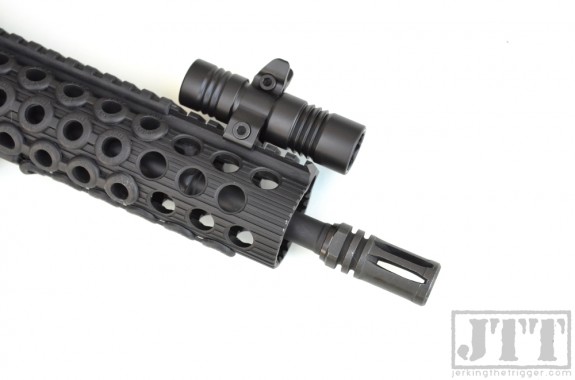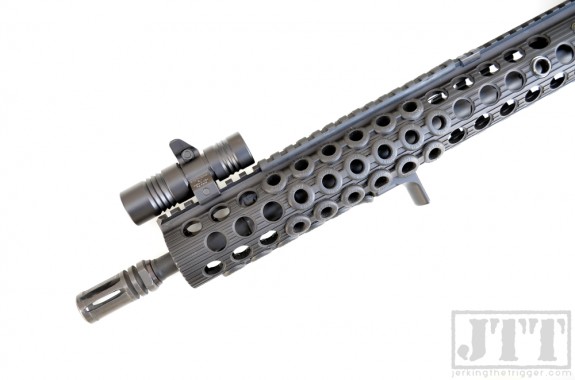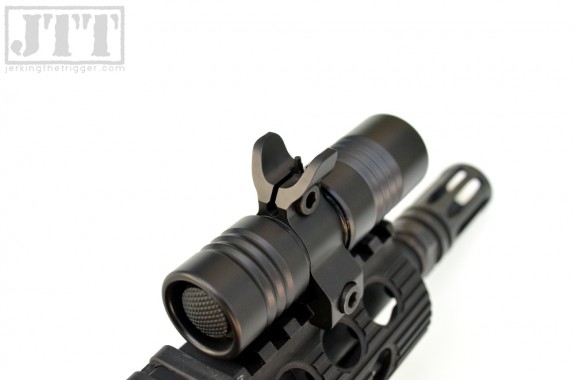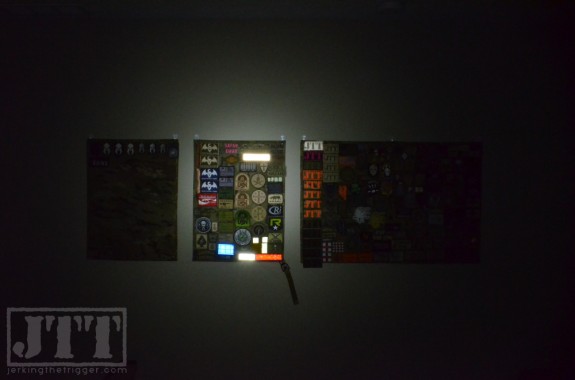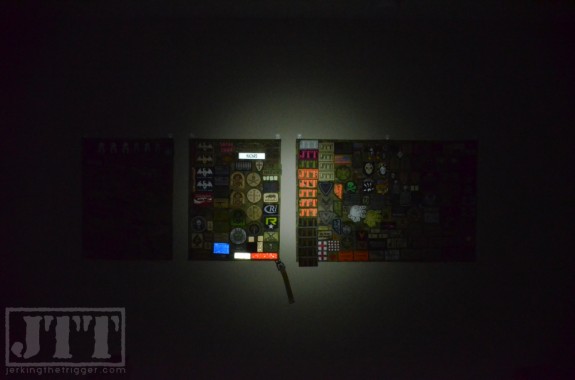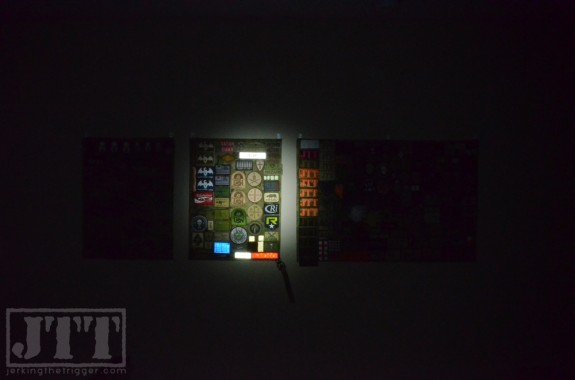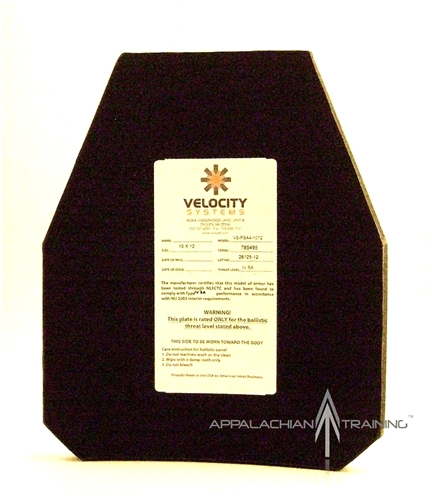The Midwest Industries MI-SSK-15 KeyMod is now available. This is the 15″ version of Midwest Industries’ KeyMod compatible, slim diameter, lightweight free float tubes. It weighs only 9.9 ounces which is quite impressive considering it is a 15″ rail. Check out the MI-SSK-15 at Midwest Industries.
Archive | November, 2013
Review: Magpul PMAG 40
I have heard that, internally, Magpul is saying that the PMAG 40 is the best magazine that they have made yet. That is really saying something considering the success of the entire PMAG line. I have now put just over 1000 rounds through a group of three PMAG 40s that I purchased when they were released and I haven’t seen anything that would cause me to disagree with Magpul’s assessment.
Magazine reviews are generally pretty boring – especially when the magazines that are being reviewed work as intended which is the case with the PMAG 40s. The PMAG 40 is a 40 round capacity version of the venerable PMAG that is just over 2″ longer than a 30 round capacity PMAG. I had zero feeding issues. They always locked the bolt back. They fit every receiver I tried. They have been durable enough for me. That is the boring stuff that has already been talked about in just about every review. So, in this review, I intend to go a little bit off the beaten path because, while reliability is essential in a magazine, it isn’t what makes the PMAG 40 special.
One of the first things that I noticed when using the PMAG 40s is how nice it is to be able to stuff them with two full boxes of ammo. Sure, that may be a small thing, but it is nice to not have to put a box and a half into each magazine like you do with a 30 round magazine. Those left over half empty boxes bother me. Again, this is a small thing. On to more notable details…
You can’t help but notice how well these magazines handle. You would think that magazine might become ungainly as the length increases but that really isn’t the case with these. They have a ton of surface area to grip so moving them around is easy. They aren’t so much heavier than a 30 round magazine that they feel burdensome. One of the better attributes of these magazines may be that they really just don’t merit much extra consideration than a 30 round magazine.
Those of you who plant the magazine on the deck when you go prone (which is hopefully all of you) will be pleased to note that you can still get quite low with the PMAG 40s. You can get lower than you would with a tradition elbows-under-the-rifle style prone, though obviously not as low as with a 30 round magazine. Several people that I shoot with have noted that they actually prefer the PMAG 40 to 30 round magazines for use as a monopod. I think I can notice that it is slightly less stable to use the PMAG 40 as a monopod versus a shorter 30 rounds magazine, but it may be in my head. Suffice it to say, they work extremely well as a monopod.
I was initially worried about finding pouches that would fit the PMAG 40s. It turns out that those fears were largely unfounded because several of my current pouches adapted well to use with the PMAG 40. The HSGI Taco pouches hold them surprisingly well. I used them on my belt in multiple training days that had me shooting from awkward positions and on VTAC barricades. The Tacos never dropped a PMAG 40 in spite of some pretty sketchy shooting positions. Esstac’s KYWI and regular adjustable magazine pouches all work well with them. UW Gear’s deep mag pouches work great if you tuck the top flap in behind the magazine (obviously, the flap won’t close over the magazine). I haven’t had any reason to go out and purchase a pouch specific to the PMAG 40s yet though it wouldn’t be a bad idea.
Finally and perhaps most subtly, the best thing about the PMAG 40s is that you can get same amount of ammo into three of them, that you can in four 30 round magazines. If you are used to using a “battle belt” you may understand why that is significant. I have generally found that placing any more than two primary magazines on a battle belt is unwieldy. The mag pouches take up too much space, the weight causes the belt to shift in strange ways, and movement generally becomes hindered. I cap my battle belt at two primary magazine reloads. That means that with two PMAG 40s on my belt and one in the gun, I can have 120 rounds on tap with fewer reloads, less weight, and less bulk than carrying the same amount of rounds in 30 round magazines. This alone makes the PMAG 40s notable for me.
PMAG 40s are reliable. They seem to be durable or at least durable enough for me. Yes, they hold 10 more rounds than most magazines and all that makes them a good magazine. However, it is all of the little ancillary details that make them a great magazine. Excuse me while I go order a few more.
Grey Ghost Gear Wraith Pack
When Grey Ghost Gear comes out with a new pack, I am always intrigued. They have a track record of creating functional, well made, and affordable packs like the Lightweight Assault Pack and Stealth Operator Pack. Their latest design, the Wraith Pack, looks primed to continue that streak.
the Wraith is a relatively compact, “assault pack.” It is designed to carry a common 2L hydration bladder (included) along with a few other essentials and it’s vertical form reflects that intended purpose. It packs 1054 cubic inches of cargo space split between a large main compartment and a smaller, front pouch. The interior of the main compartment is lined with loop material so you can customize its organization features.
Like the Lightweight Assault Pack, it comes with everything you need to mount the pack to a plate carrier or a larger pack. The pack also has multiple fields of PALS webbing on the front and sides along with compression straps to stabilize the load. The back of the Wraith has a spacer mesh pad to keep you cool and comfortable.
The Wraith Pack is available in variety of colors with lightweight 500D Cordura Nylon construction or LiteLok material construction. Check it out at Grey Ghost Gear.
Review: ROSCH Works SL1 Sight Light
There are products that I come across once in a great while that display an exceptional attention to detail. These are the products that make it obvious that the manufacturer gave thought to even the seemingly mundane details. Every choice, from the materials used, to the design of certain details, to the parties involved in the creation of the product, were scrutinized and can be explained so thoroughly that, while there may be differences in preference, you can’t be anything but impressed. The ROSCH Works SL1 Sight Light is one such product.
Overview
In the simplest terms, the SL1 is weapon mounted light with an integrated front sight. It is designed to be mounted on the 12 o’clock (top) rail of an extended railed hand guard to provide both a sight for aiming and illumination. By combining the front sight and weapon mounted light, the end user saves bulk and weight (only 3.2 ounces).
The SL1 is machined from 7075 T6 aluminum which is overkill for a flashlight and I mean that as a compliment. It is Type III hard anodized and then Cerakoted (except for the head which lacks the Cerakote, more on this later). Steel parts, like the screws and front sight are nitrocarburized (AKA Melonite, etc) to make them all but impervious to rust and to provide a matching black finish.
The rail clamp is designed to fit on standard Picatinny rail and is integral to the body of the light. In looking at pictures, some have assumed that the clamp is separate from the light but it is not. It is actually an integral part of the light’s body. The LED head and tail cap are removable.
The SL1’s LED head was co-developed by Gene Malkoff of Malkoff Devices – a giant in the arena of LED flashlights. His finger prints are all over the design and can be seen clearly in features like the fully potted electronics which means that the entire LED head is assembled and then filled with epoxy to render it one solid, nearly indestructible part. It provides a steady 250+ lumens for 50 minutes (emphasis on the +, more on this later) with several hours following of diminishing but useable light.
The SL1 is powered by a single CR123A battery which is provided. ROSCH Works also provides the hex wrench necessary to mount the SL1 and adjust the front sight, along with a sight elevation tool.
Observations from Use
Before I get too deep into my observations from using the SL1, it would be a good time for me to mention that I have written about the advantages and disadvantages of mounting your weapon light over the bore before. If you are unfamiliar with the concept it might be a good time to catch up.
The fit and finish of the SL1 is excellent. The finishes are all evenly applied and attractive. The tail cap and head threads operate smoothly and they were clean and had lubrication applied right out of the box. The LED is well centered in the reflector and the reflector is clean. The light just exudes a solid, well-made feel with obvious attention to detail.
Preparing the light for use is extremely easy. I chose the mounting location based on my typical grip location on my carbine. The switch should fall easily within reach of the support hand. You simply remove the cross bolt with the supplied hex wrench, slide the light onto the desired rail position, and then reinstall the cross bolt. The installation process should be familiar if you have ever installed any other clamp style rail mounted accessory.
Zeroing the SL1’s front sight was especially easy because I was using it to replace the front sight on an already zeroed carbine. I simply removed the old sight and then co-witnessed the new front sight to the red dot optic that remained on the carbine. It is always prudent to confirm actual zero once you get to the range, but careful co-witnessing should get you very close. The front sight consists of a threaded post that spins in a hole in between two protective “ears.” The ears are clamped together via a screw and nut. You loosen the screw to allow the front sight post to spin and tighten the screw to lock it in place. ROSCH Works provides a tool that makes turning the front sight extremely easy.
Operating the light is easy. The twisty style tail cap is simple and intuitive. I like to turn it tighter until the light comes on and then back it off just far enough that the light can’t be activated by pressing anywhere on the switch other than the button. In this position, the switch travel is short enough to be easy to activate and the risk of unintentional activation is minimized. I have had no issues with the light activating during recoil. The tail cap is very well designed with a short fence around the button to protect it from accidental activation.
The SL1’s beam pattern is just about ideal thanks to its Cree XPG2 LED under a lightly textured reflector. It has a central hotspot with a corona that gradually tapers down in intensity. The corona is quite bright and does a great job of giving you a broad picture of a dark room. The beam is optimized more for closer indoor work rather than long range outdoor work and hence the beam is more flood than throw. In fact, the SL1 has the widest beam of any weapon light that I own. However, in spite of that wide floody beam, it is still able brute force enough light to identify targets at 50 yards and even get enough light to engage a target to as far as 100 yards. The light is very white with a slightly cool color temperature and minimal depth perception robbing harsh blue tones or sickly looking greenish tones.
I compared the SL1 to several other lights with similar manufacturer’s claimed outputs. It compared very favorably and, though I can’t confirm it with any sort of measurement, it definitely seems to be putting out more than 250 lumens compared to other lights. This is pretty typical of Gene Malkoff’s lights. He often undersells the output rather than risk not living up to a claim.
The SL1 is a good enough weapon light that it is easy to lose track of the fact that it is a really excellent front sight as well. The protective ears around the sight are shaped properly to prevent distraction. The front sight is slightly tapered and narrower than a standard front sight which I like very much. It is also round with no set detent positions so it is basically infinitely adjustable. It is also very, very easy to sight in.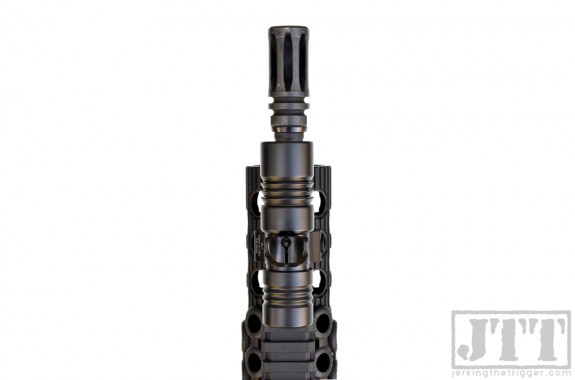
The SL1 is impressive in its compact dimensions. It is just 3.5″ long which is relatively short to begin with. However, when you add the fact that the front sight is integrated, you can start to get a sense of how much space the SL1 saves. The weight savings are equally as impressive. The light and sight set up that I replaced with the SL1 was already one of the lightest available at just 4.5 ounces (3 ounces for the light and 1.5 ounces for the sight). The SL1 weighs just 3.2 ounces and replaces both. More importantly, it is arguably a better light and a better front sight than what it replaced.
To give you an idea of the attention to detail that went into the SL1, you need to understand some of the minute aspects of the light that were considered. Here are some examples:
- The reverse polarity protection is actually physically built into the light. The positive end of the battery can’t make contact if the battery is inserted backwards.
- According to ROSCH Works, the SL1 has been “bashed into walls, dropped on concrete, tested for repeat zero, evaluated on numerous ranges at night, and so forth,” to test it.
- 7075 T6 aluminum was chosen to minimize the chances of a ham fisted users stripping out the cross-bolt threads by over tightening.
- The clamps are actually designed to make thread locker unnecessary by providing constant tension on the cross-bolts (but thread locker is provided with the SL1 for those who, like me, use it impulsively).
- ROSCH Works makes their own screws and bolts! They chose hex key screws because “You can set the torque to an approximation of 28 in-lbs without a torque driver just by tightening “hand tight” using the small handle of the hex L first and then the long handle 60 degrees (2 hours) beyond that.”
- The lens is recessed to protect it from muzzle blast and is made from tough optical acrylic with AR (anti-reflective) coating based on Gene Malkoff’s experience with LE and Military users over the years.
I find this level of detail amazing and impressive.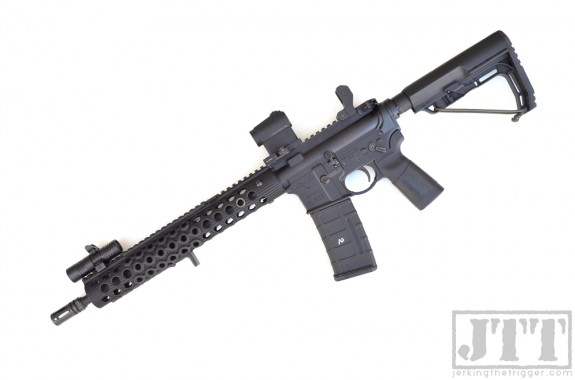
If I could change one thing, I might do something to knock down the glare on the front sight’s protective ears. They are mostly flat and can catch a bit of glare in the right situation. A little bit of glare can make them difficult to see past since they are fairly broad compared to some protective ears.
Additionally, while I generally prefer to use momentary activation for weapon light use, I have become a firm believer in a well executed forward clicky switch so that some form of constant on is easily accessible. Much of this opinion has been shaped by LEO friends in metropolitan areas. Most agree that “flash and move” is best but when you are picking your way through a derelict home with piles of junk and excrement all around that present the potential of real, physical harm… you turn your light on and leave it. To be fair, this is a preference and thankfully, ROSCH Works already has additional switch options in process.
Wrap Up
The ROSCH Works SL1 is a notable development for adherents of the 12 o’clock mounted light. It is extremely rare that a piece of gear combines two other pieces of gear and manages to actually improve both. The SL1 is a great weapon light, a great front sight, and together, it feels like something entirely new. This is a tremendous product.
Check out the SL1 from ROSCH Works.
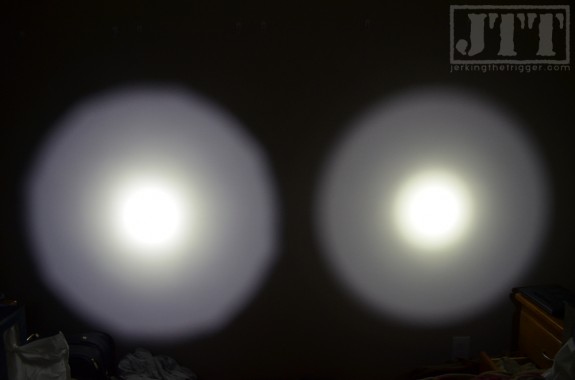
The SL1 and 200 lumen INFORCE WML have similar beam profiles though the SL1 is wider and brighter (SL1 on left, WML on right, 5 feet from off-white wall).
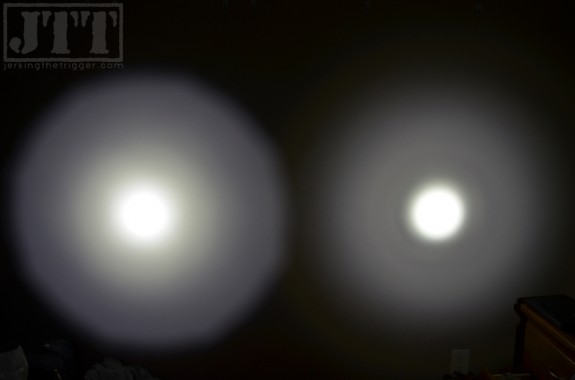
The the SL1 (left) has a wider beam than the Surefire X300 (right) though the X300 does have more throw (5 feet from off-white wall).
Appalachian Training Steel Armor Trade-In Program
Appalachian Training is waging a campaign against substandard steel armor plates, many of which simply do not perform to the standard the standard that they say they do. Mike, the owner at Appalachian Training, had this to say about target grade steel armor plates:
Steel is applicable in very limited situations where a low vis specific rifle protection requirement is present. And that requires specific steel such as Velocity low vis or AMIs steel packages. Again, steel is for VERY specific PSD / agency requirements. The target type cheap steel armor has NO place in a modern plate carrier for professionals or citizens. It is a non-solution to a real problem set (much like a serpa holster).
You can now trade your steel plates into Appalachian Training for a significant discount on a proper set of plates. If you send your steel plates, you will receive a discount code to purchase a set of Velocity Systems Level IV Stand Alone Armor Plates for just $499.99 plus shipping (normal price is $659.90 plus shipping).
Get in touch with Appalachian Training to get your trade-in started.
